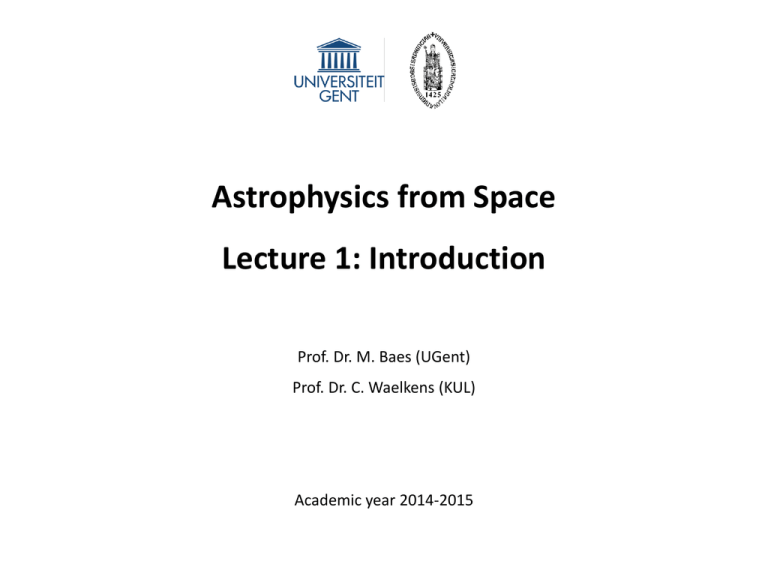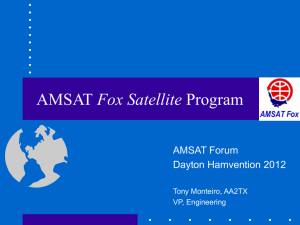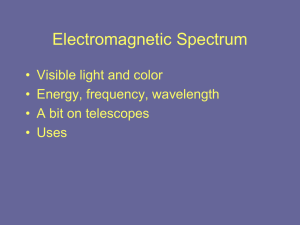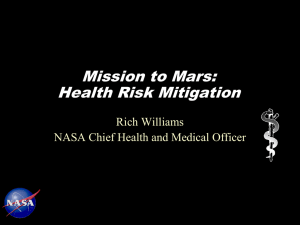Lecture01
advertisement

Astrophysics from Space Lecture 1: Introduction Prof. Dr. M. Baes (UGent) Prof. Dr. C. Waelkens (KUL) Academic year 2014-2015 The electromagnetic spectrum radio Ch. 8 infrared Ch. 4 & 5 optical Ch. 2 & 3 high-energy Ch. 6 & 7 The goal of this course Discuss the history, benefits, possibilities, limitations and (some) major accomplishments of astrophysics space missions in the optical, infrared, high-energy and radio wavelength regimes. Why different wavelength regimes ? Theoretically: no fundamental difference between radiation in the different wavelength regimes Practically, there is a huge difference: • difference in atmospheric properties • difference in telescope/detector properties • difference in physical processes dominating the emission Each wavelength range contains information that we usually cannot obtain from observations in other wavelength regimes. Radiation processes: blackbody radiation Planck radiation law Things to remember • continuum radiation • Wien’s displacement law • Stefan-Boltzmann law Radiation processes: line radiation Line radiation can be used in many ways • chemistry: each element has different lines • temperature, ionization…: from line ratios • kinematics: from Doppler shift • magnetic fields: from Zeeman effect Example: hydrogen atom NIR radio (21 cm) optical UV Even hydrogen, the most abundant and most simple element, has different lines in the UV, optical, nearinfrared and radio regimes. Radiation processes: there are more… Bremsstrahlung Synchrotron radiation Multiwavelength view of Cen A Optical radiation is dominated by emission from normal stars… Significant obscuration by interstellar dust. Multiwavelength view of Cen A NIR radiation is dominated by emission from cooler stars… Bright central condensation of stars. Obscuration by dust is much less pronounced Multiwavelength view of Cen A UV radiation is dominated by emission from hot and young stars… Bulge disappears and young stellar disc appears. Obscuration by dust is dramatic ! Multiwavelength view of Cen A Mid-infrared emission is dominated by thermal emission from warm dust (reprocessed energy). FIR image would trace the cooler dust (not in starforming regions). Multiwavelength view of Cen A X-ray image shows synchrotron radiation from the jet, coming from the supermassive black hole in the centre. Isolated X-ray sources are neutron stars or background sources. Multiwavelength view of Cen A 6 cm radio image is similar to X-ray image: dominated by synchrotron emission from jets linked to the supermassive black hole. Main driver for astrophysics from space A solid understanding of the Universe requires a multiwavelength view. The only way to do this is observations from space. Note: this is not the only reason why we want to go to space… Europe in space: ESA 21 member states annual budget (2015) ~ 4.43 G€ ESA budget ESA integrated science program 1983-1984: Horizon 2000 1994-1995: Horizon 2000+ (Cosmic Vision 2005-2015) 2004-2005: Cosmic Vision 2015-2025 Integrated long-term plans identifying the major scientific questions to be addressed by ESA’s future science missions • astrophysics, exploration and fundamental physics • intense collaboration between ESA and community • Cosmic Vision: combination of S, M and L missions http://sci.esa.int/science-e/www/area/index.cfm?fareaid=100 Cosmic Vision 2015-2025 S-class missions (<50 M€) • S1: CHEOPS (selected in 2012, launch in 2017) M-class missions (<470 M€) • M1: Solar Orbiter (selected in 2011, launch in 2017) • M2: Euclid (selected in 2011, launch in 2020) • M3: PLATO (selected in 2014, launch in 2024) • M4: selection in 2015, launch in 2025 L-class missions (<900 M€) • L1: JUICE (selected in 2012, launch in 2022) • L2: ATHENA (selected in 2014, launch in 2028) • L3: selection in 2016, launch in 2034 Europe in space: national agencies 1.7 G€ 1.3 G€ 1 G€ Belgium: has not developed a purely national large space program (deliberately chosen the European route) http://www.esa.int/esapub/hsr/HSR_29.pdf NASA Remarkable: NASA budget ~ 17.8 billion USD NASA • US has enormous history in space exploration since 1950s • Dramatic cuts in 1970s • Significant disasters have shaken NASA (with repercussions on the science program) 1986 2003 NASA Science NASA Science focuses on four broad themes - better understanding of Earth itself - Solar System exploration - heliophysics - astrophysics http://science.nasa.gov/ NASA Great Observatories Series of four large space missions - each in a different wavelength region - each of similar size and cost (at program outset) - synergy to increase the science output HST (1990-) CGRO (1991-2000) Chandra (1999-) Spitzer (2003-) NASA Origins theme Japan: JAXA Important player in space astrophysics - launched its first satellite in 1970 - stress on X-ray and infrared astronomy - pioneer in radio astronomy from space Collaboration between JAXA and ESA/NASA for several missions Akari Suzaku USSR and Russia USSR was the first space power with many firsts Striking: almost no involvement in astrophysics programs Russian space program is focused on launching and space station. Other countries Countries with manned space programmes Other countries Countries with space launch capabilities Other countries Countries with national space agencies Many countries have space agencies and plans for space programs in the near future. Modest involvement in astrophysics (so far).









